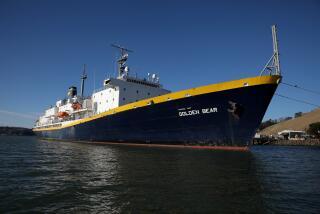Woman Sails on Seiner, Deep-Sixing Male Bastion
- Share via
When Susan Taveras set sail Monday night aboard the seiner Antonina C, the era of male-only government observers on San Diego’s tuna boats came to an end.
And the tuna industry discovered its latest controversy.
The American Tunaboat Assn., which represents the 32 vessels in the local fishing fleet, is registering vehement opposition to a new federal policy that for the first time allows women marine biologists to spend 50 to 100 days at sea with all-male tuna boat crews.
But officials of the National Marine Fisheries Service say that they are no longer going to prevent women from joining their observer corps, and that boat owners must comply with the rules if they want to fish the eastern Pacific.
Tuna boats follow porpoises to find the schools of tuna that they harvest in huge “purse seine” nets. Because the nets also capture and kill porpoises, the government assigns observers to insure that the fishermen do not exceed their quota of 20,500 porpoise kills in any year. The observers also gather scientific data on the porpoises.
Under orders from its parent agency, the National Oceanic and Atmospheric Administration, to desegregate its observer corps, the Fisheries Service schooled four women along with about 15 men in its most recent four-week class in San Diego. Taveras was the first to head to sea, and three others are awaiting assignment.
August Felando, president of the tuna boat association, said that boat owners were given an ultimatum by Fisheries Service officials: If they did not accept women observers, they would be denied permission to fish among the porpoise schools--a practice that accounts for virtually all of the tuna catch.
“The thing that concerns me more than anything else is the way the government is telling the boat owner and the captain and crew and the families on shore that they have no choice on the matter,” Felando said.
Felando said that he is not questioning women observers’ qualifications, but claimed that their presence in the all-male bastion of the tuna boat “represents changed circumstances for us” and affects “the primary purpose of the voyage”--catching tuna.
With fishermen bunking four or eight to a room, women will not be easily accommodated on the boats and privacy intrusions are inevitable, Felando said. Captains and crews could be exposed to sexual harassment suits and fishermen’s families will have another reason to be anxious while their men are on months-long voyages.
Actually, Taveras is bunking two-to-a-room with the Antonina C’s navigator on her maiden voyage, and will have the relative luxury of sharing a bathroom only with him, said Norman Mendes, San Diego branch manager for the National Marine Fisheries Service. It will not be difficult for her and the navigator to change clothes and shower privately.
But the agency is willing to put female observers in four-person rooms, he said.
Though the Fisheries Service is bound to carry out the new rules, “we don’t know how it’s going to work,” said Charles Fullerton, the agency’s regional director. “With the mixed bunking and all, we don’t know how well it’s going to work.
“It’s a shock to the industry. It’s a change.”
Women have been employed as American observers on foreign fishing vessels for five years, with few incidents, Fullerton said. In what was apparently the only incident of its kind, the captain of a Korean ship allegedly attempted to rape an observer during her first assignment aboard ship, then terrorized her during the nine days before she was able to leave the ship by feigning illness.
Criminal and civil charges against the captain, Lee Jung Sik, are pending in an Anchorage, Alaska, court.
Taveras had to weather a session with tuna boat owners, their attorneys and some boat captains, who barraged her with personal questions in what appeared to be an effort to intimidate her, Mendes said.
“I think they were trying to find out what she is made of,” Mendes said.
“She is a level-headed woman with a lot of moxie and a lot of past experiences that make her qualified as an observer.”
Observers earn about $2,500 per month during the two or three trips they make with tuna boats each year under the 11-year-old Tuna-Porpoise Program, Mendes said. Problems with crew members are ironed out among themselves or settled by the ship’s captain, he said.
More to Read
Sign up for Essential California
The most important California stories and recommendations in your inbox every morning.
You may occasionally receive promotional content from the Los Angeles Times.













